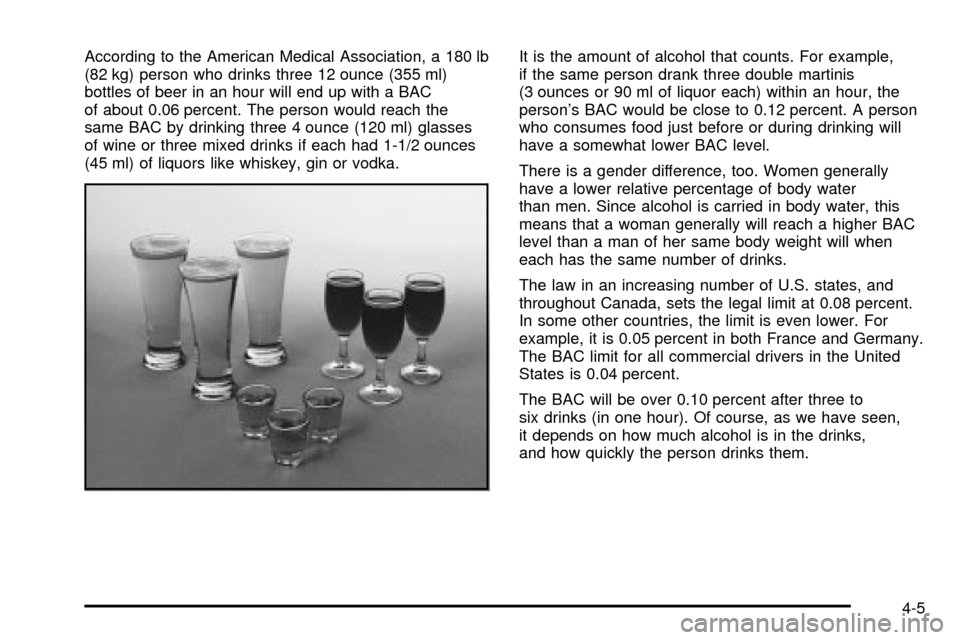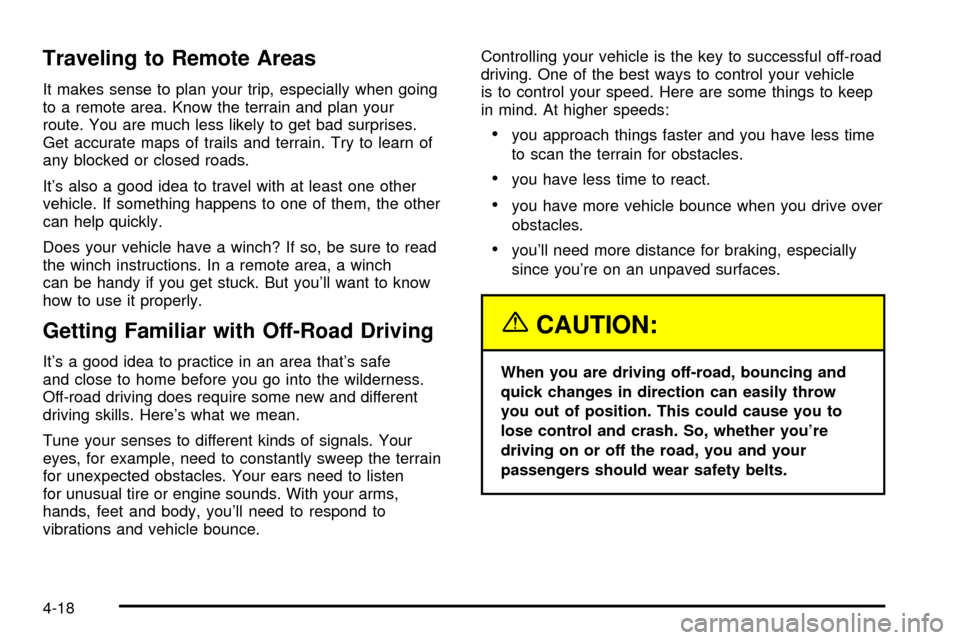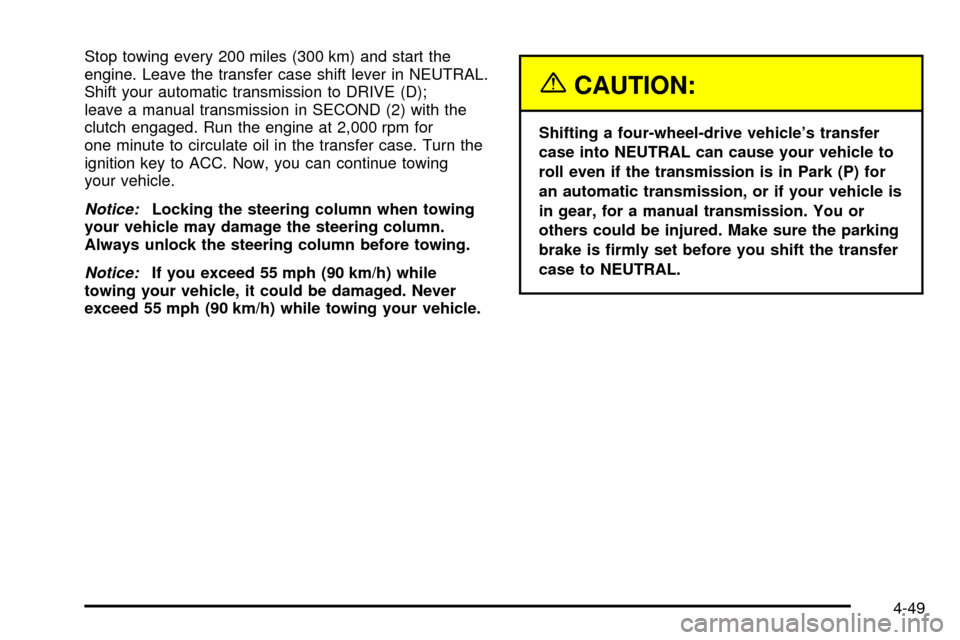key CHEVROLET TRACKER 2003 2.G Owner's Guide
[x] Cancel search | Manufacturer: CHEVROLET, Model Year: 2003, Model line: TRACKER, Model: CHEVROLET TRACKER 2003 2.GPages: 372, PDF Size: 2.65 MB
Page 147 of 372

·Sometimes when the engine is idling at a stop, the
light may blink on and off. This is normal.
·If you make a hard stop, the light may come on for
a moment. This is normal.
{CAUTION:
Do not keep driving if the oil pressure is low.
If you do, your engine can become so hot that
it catches ®re. You or others could be burned.
Check your oil as soon as possible and have
your vehicle serviced.
Notice:Damage to your engine from neglected oil
problems can be costly and is not covered by
your warranty.
Overdrive Off Light
This light comes on when
the automatic four-speed
transmission, if equipped,
has been converted to the
three-speed mode and the
overdrive is turned off.
This light also comes on as a check for about ®ve
seconds when the ignition key is turned to ON or
START.
Four-Wheel-Drive Light
If you have four-wheel
drive, this light comes on
when the ignition switch
is on and the transfer case
lever is in one of the
four-wheel drive positions.
See
Four-Wheel Drive on page 5-53.
3-35
Page 148 of 372

Power Indicator Light
This light comes on when
the power mode selector
switch, if equipped, is
turned to P (power) with
the ignition switch in
the ON position.
This light comes on as a check for about ®ve seconds
when the ignition key is turned to ON or START.
Fuel Gage
Your fuel gage shows
about how much fuel is
in your tank. When the
gage ®rst indicates
E (empty), you still have
about one or two gallons
(4 to 8 L) of fuel left in your
tank, but you need to get
more right away.Here are four concerns some owners have had about
the fuel gage. All these situations are normal and do not
indicate that anything is wrong with the fuel gage.
·At the gas station, the fuel pump shuts off before the
gage reads F (full).
·It takes more (or less) fuel to ®ll up than the gage
reads. For example, the gage reads half full, but it
took more (or less) than half of the tank's
capacity to ®ll it.
·The gage moves a little when you turn, stop or
speed up.
·When you turn the engine off, the gage doesn't go
back to E (empty).
·It takes several minutes for the gage to read F (full)
after ®lling the tank.
3-36
Page 161 of 372

According to the American Medical Association, a 180 lb
(82 kg) person who drinks three 12 ounce (355 ml)
bottles of beer in an hour will end up with a BAC
of about 0.06 percent. The person would reach the
same BAC by drinking three 4 ounce (120 ml) glasses
of wine or three mixed drinks if each had 1-1/2 ounces
(45 ml) of liquors like whiskey, gin or vodka.It is the amount of alcohol that counts. For example,
if the same person drank three double martinis
(3 ounces or 90 ml of liquor each) within an hour, the
person's BAC would be close to 0.12 percent. A person
who consumes food just before or during drinking will
have a somewhat lower BAC level.
There is a gender difference, too. Women generally
have a lower relative percentage of body water
than men. Since alcohol is carried in body water, this
means that a woman generally will reach a higher BAC
level than a man of her same body weight will when
each has the same number of drinks.
The law in an increasing number of U.S. states, and
throughout Canada, sets the legal limit at 0.08 percent.
In some other countries, the limit is even lower. For
example, it is 0.05 percent in both France and Germany.
The BAC limit for all commercial drivers in the United
States is 0.04 percent.
The BAC will be over 0.10 percent after three to
six drinks (in one hour). Of course, as we have seen,
it depends on how much alcohol is in the drinks,
and how quickly the person drinks them.
4-5
Page 174 of 372

Traveling to Remote Areas
It makes sense to plan your trip, especially when going
to a remote area. Know the terrain and plan your
route. You are much less likely to get bad surprises.
Get accurate maps of trails and terrain. Try to learn of
any blocked or closed roads.
It's also a good idea to travel with at least one other
vehicle. If something happens to one of them, the other
can help quickly.
Does your vehicle have a winch? If so, be sure to read
the winch instructions. In a remote area, a winch
can be handy if you get stuck. But you'll want to know
how to use it properly.
Getting Familiar with Off-Road Driving
It's a good idea to practice in an area that's safe
and close to home before you go into the wilderness.
Off-road driving does require some new and different
driving skills. Here's what we mean.
Tune your senses to different kinds of signals. Your
eyes, for example, need to constantly sweep the terrain
for unexpected obstacles. Your ears need to listen
for unusual tire or engine sounds. With your arms,
hands, feet and body, you'll need to respond to
vibrations and vehicle bounce.Controlling your vehicle is the key to successful off-road
driving. One of the best ways to control your vehicle
is to control your speed. Here are some things to keep
in mind. At higher speeds:
·you approach things faster and you have less time
to scan the terrain for obstacles.
·you have less time to react.
·you have more vehicle bounce when you drive over
obstacles.
·you'll need more distance for braking, especially
since you're on an unpaved surfaces.
{CAUTION:
When you are driving off-road, bouncing and
quick changes in direction can easily throw
you out of position. This could cause you to
lose control and crash. So, whether you're
driving on or off the road, you and your
passengers should wear safety belts.
4-18
Page 204 of 372

Dinghy Towing
To tow your vehicle from the front (four-wheel-drive only),
do the following:
Notice:If you tow a two-wheel-drive vehicle with all
four wheels on the ground, the transmission could be
damaged. The repairs would not be covered by your
warranty. Do not tow a two-wheel-drive vehicle with
all four wheels on the ground.Follow these steps:
1. Set the parking brake.
2. Shift your automatic transmission into PARK (P),
or your manual transmission to SECOND (2).
3. With the ignition key in the ON position, move the
transfer case to NEUTRAL and make sure the
4WD light on the instrument panel cluster is off.
See
Four-Wheel Drive on page 5-53.
4. Turn the ignition key to ACC.
5. Release the parking brake.
Notice:If you do not put the transfer case in
NEUTRAL before towing a four-wheel-drive vehicle
from the front, the vehicle could be damaged.
The repairs would not be covered by your warranty.
Always put the transfer case in NEUTRAL before
towing your vehicle.
4-48
Page 205 of 372

Stop towing every 200 miles (300 km) and start the
engine. Leave the transfer case shift lever in NEUTRAL.
Shift your automatic transmission to DRIVE (D);
leave a manual transmission in SECOND (2) with the
clutch engaged. Run the engine at 2,000 rpm for
one minute to circulate oil in the transfer case. Turn the
ignition key to ACC. Now, you can continue towing
your vehicle.
Notice:Locking the steering column when towing
your vehicle may damage the steering column.
Always unlock the steering column before towing.
Notice:If you exceed 55 mph (90 km/h) while
towing your vehicle, it could be damaged. Never
exceed 55 mph (90 km/h) while towing your vehicle.
{CAUTION:
Shifting a four-wheel-drive vehicle's transfer
case into NEUTRAL can cause your vehicle to
roll even if the transmission is in Park (P) for
an automatic transmission, or if your vehicle is
in gear, for a manual transmission. You or
others could be injured. Make sure the parking
brake is ®rmly set before you shift the transfer
case to NEUTRAL.
4-49
Page 206 of 372

Dolly Towing
To tow your vehicle from the rear, do the following:
The best way to tow your vehicle is from the rear.
Follow these steps:
1. Put the rear wheels on a dolly.
Notice:If you tow a two-wheel-drive vehicle with
the rear wheels on the ground, the transmission
could be damaged. The repairs would not be
covered by your warranty. Never tow your vehicle
with the rear wheels on the ground.2. If your vehicle is a four-wheel-drive vehicle,
turn the ignition key to ON, move the transfer case
lever into NEUTRAL and make sure the 4WD
light on the instrument panel cluster is turned off.
See
Four-Wheel Drive on page 5-53.
3. Turn the ignition key to ACC.
4. Make sure the front wheels are facing straight
forward and secure the steering wheel with a
steering wheel clamping device designed for towing.
Notice:If you exceed 55 mph (90 km/h) while
towing your vehicle, it could be damaged. Never
exceed 55 mph (90 km/h) while towing your vehicle.
{CAUTION:
Shifting a four-wheel-drive vehicle's transfer
case into NEUTRAL can cause your vehicle to
roll even if the transmission is in Park (P) for
an automatic transmission, or if your vehicle is
in gear, for a manual transmission. You or
others could be injured. Make sure the parking
brake is ®rmly set before you shift the transfer
case to NEUTRAL.
4-50
Page 285 of 372

The tools you'll be using include the jack (A), jack
handle (B) and wheel wrench (C).
The spare tire is mounted on your tailgate. Your
vehicle may be equipped with either a soft,
vinyl cover or a hard cover.3. To remove the hard
cover from the spare
tire, insert your key into
the wheel lock and
pull the wheel lock off.
Hard Cover
5-69
Page 286 of 372

4. Using the wheel wrench, remove the wheel cover
nut. Gently pry the spare tire cover off the wheel.5. If your vehicle is equipped with a vinyl cover, unzip
the cover to ®nd the wheel lock. Insert the key into
the wheel lock and pull it off.
6. Using the wheel wrench, remove the wheel nut
under the lock.Vinyl Cover
5-70
Page 311 of 372

Normal Maintenance Replacement Parts
Part GM Part Number
Engine Air Cleaner/Filter 30025009 or equivalent
Engine Oil Filter
2.0L Engine
2.5L Engine91173772 or equivalent
91176162 or equivalent
Passenger Compartment Air Filters 91175923 or equivalent
PCV Valve
2.0L Engine
2.5L Engine91174516 or equivalent
91176183 or equivalent
Remote Keyless Entry Transmitter Battery 3-volt CR2032 or equivalent
Spark Plugs91176020 (NGK IFR5J11/Iridium plug),
91173854 (NGK BKR6E11/Nickel plug) or
91173855 (DENSO K20PR-U11/Nickel plug)
5-95